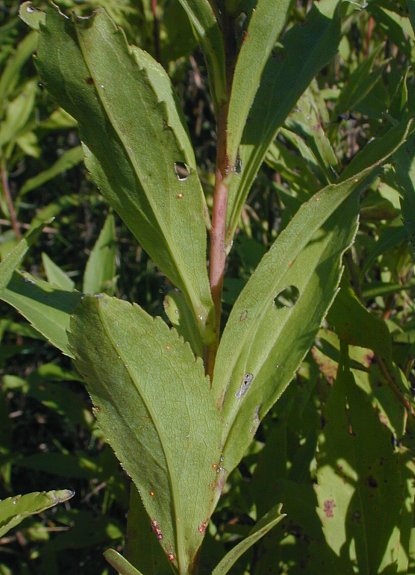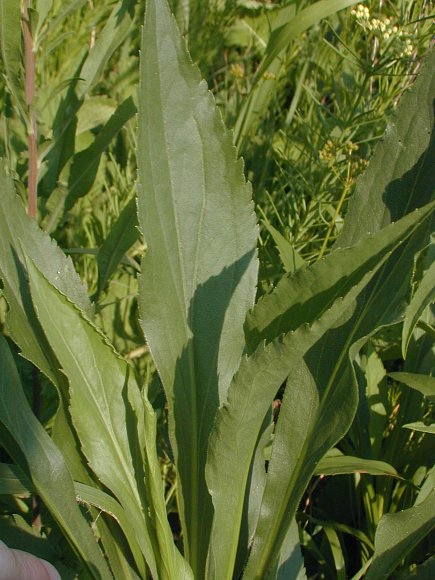Description: This perennial plant is about 1½–3' tall and unbranched, except for the flowering stalks near the apex. Missouri Goldenrod produces both fertile (flowering) and sterile (non-flowering) shoots. The central stem is light green to dark red, terete (round in circumference), and glabrous; the lower portion of this stem may become slightly woody with age. Along the entire length of this stem, there are alternate leaves that become smaller as they ascend. These leaves are up to 5" long and ¾" across; they are more or less elliptic in shape and serrated along their middle to outer margins. Each leaf usually has 3 prominent veins (a central vein & 2 lateral veins); the lateral veins are parallel with the central vein along much of its length. However, on many upper leaves only the central vein is prominent. The tips of the leaves are acute, while their bases taper gradually into petioles. Most of these petioles are 3 mm. or less in length, although the lowest leaves have longer petioles that are partially winged. From the axils of the middle to upper leaves, short tufts of small secondary leaves may develop. The upper leaf surface is medium green and glabrous, while the lower leaf surface is light green and glabrous.

A panicle of flowerheads up to 6" long and 4" across terminates the central stem of each fertile shoot. This panicle is pyramidal, obpyramidal, or rhomboid in outline; its branches are widely spreading to ascending and straight to somewhat recurved. These branches divide into short secondary branches and peduncles; the latter terminate in small flowerheads. The branches and peduncles are light green to nearly white and either glabrous or pubescent. Intermingled among these branches, there are small leafy bracts up to 1½" long and ¼" (6 mm.) across. Each flowerhead is about 3 mm. across and 5 mm. long; it consists of several disk florets that are surrounded by 6-12 ray florets. The tiny corollas of these florets are yellow to golden yellow; they are tubular in shape with 5 spreading to ascending lobes along their upper rims. The petaloid rays of the flowerheads are bright yellow, oblong in shape, and widely spreading. Surrounding the base of each flowerhead, there are phyllaries (floral bracts) in several overlapping series; they are about 2 mm. long, light green to light yellow, oblong in shape, glabrous, and appressed together. The blooming period usually occurs from mid-summer to late summer, lasting about 3 weeks for a colony of plants. Afterwards, the florets are replaced by achenes with small tufts of white hair at their apices. These achenes are about 2 mm. long and bullet-shaped; they are distributed by the wind.

The root system is
mostly fibrous and rhizomatous; an older plant
may produce a small caudex. Missouri Goldenrod reproduces by clonal
offsets from the rhizomes and by reseeding itself. It often forms
colonies that contain both fertile and infertile shoots.
Cultivation:
The preference is full sun to partial sun, mesic to dry conditions, and
soil that contains loam, clay-loam, or rocky material. Like many
goldenrod species, Missouri Goldenrod is easy to grow. While this
goldenrod will spread in cultivation from its rhizomes, it is shorter
and less aggressive than the common Canada Goldenrod (Solidago
canadensis).
Range & Habitat:
Missouri Goldenrod occurs occasionally in most areas of Illinois (see Distribution
Map),
where it is native. Habitats include black soil prairies, clay
prairies, dolomite prairies, hill prairies, limestone glades, prairie
remnants along railroads, and thickets in upland areas. In Illinois,
this goldenrod has high fidelity to prairies that can vary in their
quality. Because of the destruction of prairie habitat, it is less
common within the state than in the past.

Faunal
Associations:
Small bees, wasps, flies, and beetles visit the flowers for nectar
and/or pollen, including Chauliognathus pennsylvanica
(Goldenrod Soldier Beetle) and Epicauta pensylvanica
(Black Blister Beetle). Many grasshopper species feed on the foliage of
Missouri Goldenrod (see Grasshopper Table), as do the
leaf beetles Microrhopala vittata, Trirhabda
borealis, Trirhabda canadensis, Trirhabda
convergens, and Trirhabda virgata. The
caterpillars of many moth species feed on this and other goldenrods
(see Moth
Table). Other insect feeders include stink bugs, plant bugs,
the larvae of small flies (Tephritidae), and thrips. The Greater
Prairie Chicken eats the foliage,
while the Eastern Goldfinch and various sparrows eat the seeds to a
minor extent. Although goldenrods are not preferred as a food
source, the
White-Tailed Deer, Cottontail Rabbit, and livestock eat the foliage
occasionally. Prairie Voles and Meadow Voles eat both the seeds and
foliage.
Photographic Location:
The Buffalo Trace Prairie at Lake-of-the-Woods, Champaign County,
Illinois, and a wildflower garden of the webmaster in Urbana, Illinois.

Comments: Missouri Goldenrod (Solidago missouriensis) is rather variable across its range, making it difficult to distinguish from other goldenrods (Solidago spp.). More specifically, the shape of the inflorescence of this goldenrod is rather variable, the leaves vary in regards to how much smaller they become as they ascend the stems, and the flowering branches can be glabrous or pubescent. In particular, Missouri Goldenrod can be difficult to distinguish from Early Goldenrod (Solidago juncea). Both of these goldenrods bloom earlier than most goldenrods and they are found in similar habitats. While Early Goldenrod begins to bloom about 2 weeks earlier than Missouri Goldenrod, there blooming periods overlap to some extent. Usually the inflorescence of Early Goldenrod has flowering branches that are more recurved and widely spreading than those of Missouri Goldenrod, and it lacks 3-veined leaves. Another goldenrod that Missouri Goldenrod has some resemblance to, Giant Goldenrod (Solidago gigantea), differs by its greater height, later blooming period, and preference for damp habitats. The leaves of Giant Goldenrod vary little in size as they ascend the stems, while the leaves of Missouri Goldenrod are more likely to become smaller. Another rather variable species, Showy Goldenrod (Solidago speciosa), also differs by its greater height and later blooming period. In addition, it lacks the 3-veined leaves of Missouri Goldenrod, and the flowering branches of its panicles curve inward, rather than outward.